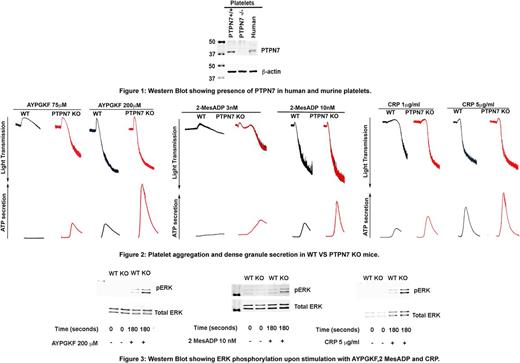Abstract
Background: Thromboxane is a short-lived lipid mediator which recruits more platelets to site of vascular injury. Dysregulation of thromboxane generation can lead to several thrombotic complications such as stroke and myocardial infarction. In platelets, thromboxane generation is regulated by extracellular signal-regulated protein kinase 1/2 (ERK1/2) and therefore it is important to understand how ERK is regulated in platelets. In lymphocytes, ERK phosphorylation is regulated by a non-transmembrane protein tyrosine phosphatase PTPN7. In this study we investigated the presence of PTPN7 in platelets and effect of PTPN7 deficiency on platelet activation.
Results: Western blot analysis revealed that PTPN7 is present in both human and murine platelets (Fig. 1). PTPN7 KO murine platelets show increased platelet functional responses such as aggregation, dense granule secretion and thromboxane generation upon stimulation with both GPCR and GPVI agonists (Fig. 2). In the presence of COX inhibitor indomethacin, the PTPN7 KO murine platelets aggregate and secrete to the same extent as the WT. This suggests that elevated thromboxane A2 levels are responsible for potentiation of platelet functional responses. ERK phosphorylation is also potentiated in PTPN7 KO (Fig.3) and the activity of signaling molecules upstream of ERK such as MEK is unaffected. This shows that specificity of the PTPN7 towards ERK in platelets. Lastly, in pulmonary embolism model PTPN7 KO mice have shorter time to death due to pulmonary thrombosis.
Conclusions: PTPN7 is a negative regulator ERK phosphorylation and thromboxane generation in platelets.
No relevant conflicts of interest to declare.
Author notes
Asterisk with author names denotes non-ASH members.


This feature is available to Subscribers Only
Sign In or Create an Account Close Modal